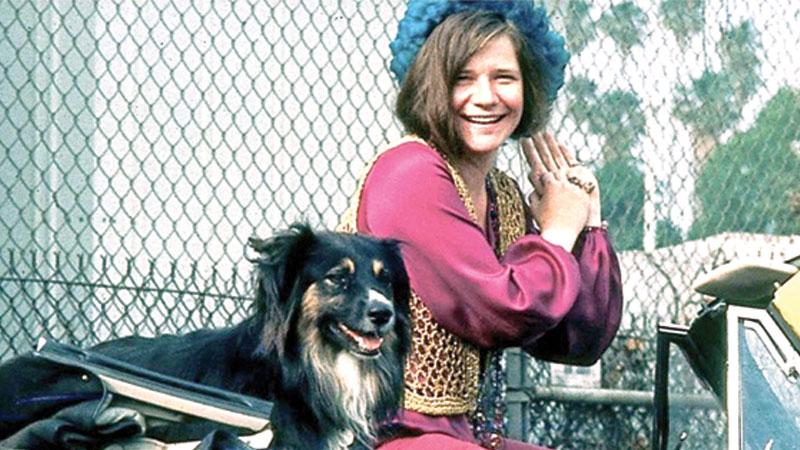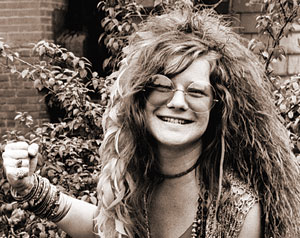
anis Lyn Joplin (January 19, 1943 – October 4, 1970) was an American singer-songwriter who sang rock, soul and blues music. One of the most successful and widely known rock stars of her era, she was noted for her powerful mezzo-soprano vocals and “electric” stage presence.
Career
Joplin cultivated a rebellious manner and styled herself partly after her female blues heroines and partly after the Beat poets. Her first song, What Good Can Drinkin’ Do, was recorded on tape in December 1962 at the home of a fellow University of Texas student.
She left Texas in January 1963 (“Just to get away,” she said, “because my head was in a much different place”), hitchhiking with her friend Chet Helms to North Beach, San Francisco. Still in San Francisco in 1964, Joplin and future Jefferson Airplane guitarist Jorma Kaukonen recorded a number of blues standards, which incidentally featured Kaukonen’s wife Margareta using a typewriter in the background. This session included seven tracks: Typewriter Talk, Trouble in Mind, Kansas City Blues, Hesitation Blues, Nobody Knows You When You’re Down and Out, Daddy, Daddy, Daddy, and Long Black Train Blues It was was released long after Joplin’s death as the bootleg album The Typewriter Tape.
In 1963, Joplin was arrested in San Francisco for shoplifting. During the two years that followed, her drug use increased and she acquired a reputation as a “speed freak” and occasional heroin user. She also used other psychoactive drugs and was a heavy drinker throughout her career.
In May 1965, Joplin’s friends in San Francisco, noticing the detrimental effects on her from regularly injecting methamphetamine (she was described as “skeletal” and “emaciated”), persuaded her to return to Port Arthur.
During that month, her friends threw her a bus-fare party so she could return to her parents in Texas. Five years later, Joplin told Rolling Stone magazine writer David Dalton the following about her first stint in San Francisco: “I didn’t have many friends and I didn’t like the ones I had.”
Back in Port Arthur in the spring of 1965, after Joplin’s parents noticed her weight of 88 pounds (40 kg), she changed her lifestyle. She avoided drugs and alcohol, adopted a beehive hairdo, and enrolled as anthropology major at Lamar University in nearby Beaumont, Texas. During her time at Lamar University, she commuted to Austin to sing solo, accompanying herself on acoustic guitar. One of her performances was at a benefit by local musicians for Texas bluesman Mance Lipscomb, who was suffering with ill health.
Joplin became engaged to Peter de Blanc in the fall of 1965. She had begun a relationship with him towards the end of her first stint in San Francisco. Now living in New York where he worked with IBM computers, he visited her to ask her father for her hand in marriage. Joplin and her mother began planning the wedding. De Blanc, who travelled frequently, ended the engagement soon afterwards.
In 1965 and 1966, Joplin commuted from her family’s Port Arthur home to Beaumont, Texas, where she had regular sessions with a psychiatric social worker named Bernard Giarritano at a counseling agency which was funded by the United Fund, which after her death changed its name to the United Way. Interviewed by biographer Myra Friedman after his client’s death, Giarritano said Joplin had been baffled by how she could pursue a professional career as a singer without relapsing into drugs, and that her drug-related memories from immediately prior to returning to Port Arthur continued to frighten her. Joplin sometimes brought an acoustic guitar with her to her sessions with Giarritano, and people in other offices within the building could hear her singing.
Giarritano tried to reassure her that she did not have to use narcotics in order to succeed in the music business. She also said that if she were to avoid singing professionally, she would have to become a keypunch operator (as she had done a few years earlier) or a secretary, and then a wife and mother, and she would have to become very similar to all the other women in Port Arthur.
Approximately a year before Joplin joined Big Brother and the Holding Company, she recorded seven studio tracks with her acoustic guitar. Among the songs she recorded were her original composition for the song Turtle Blues and an alternate version of Codine by Buffy Sainte-Marie. These tracks were later issued as a new album in 1995, titled This is Janis Joplin 1965 by James Gurley.
Joplin died of an accidental heroin overdose in 1970 aged 27, after releasing three albums. A fourth album, Pearl, was released in January 1971, just over three months after her death. It reached number one on the Billboard charts. She was posthumously inducted into the Rock and Roll Hall of Fame in 1995. Rolling Stone ranked Joplin number 46 on its 2004 list of the 100 Greatest Artistes of All Time and number 28 on its 2008 list of 100 Greatest Singers of All Time. She remains one of the top-selling musicians in the United States, with Recording Industry Association of America certifications of 18.5 million albums sold.
